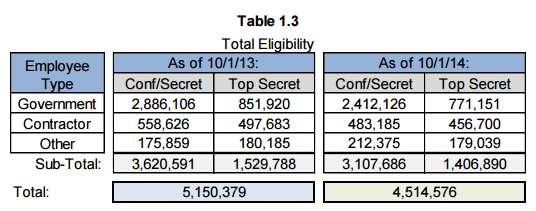The government has cut the number of individuals holding federal security clearances by more than 635,000. The Office of the Director of National Intelligence released their 2014 Report on Security Clearance Determinations this week. It’s the latest installment of an annual report required by the 2010 Intelligence Authorization Act. The report includes data on the number of cleared employees and contractors, as well as current security clearance processing times.
It’s the latest report highlighting the results of a government-wide effort to reduce the size of the cleared workforce, in an effort to save money and combat insider threats such as the massive leaks by former NSA contractor Edward Snowden. A Department of Defense report provided to ODNI last month outlined that agency’s success in reducing its cleared workforce by 15 percent.
The ODNI figures break down the Intelligence Community’s reduction in total eligibility, including reducing those ‘in access’ as well as those ‘eligible (not in access)’. As of October 1, 2014, there were 471,302 fewer individuals eligible and 164,501 fewer individuals ‘in access.’
The significant majority of the reductions came from the cleared ‘bench’ – those individuals who possess a clearance but don’t need access to classified information to do their jobs. This affects cleared contractors who rely on cleared workers to deploy quickly as new contracts are awarded. Particularly in today’s competitive contracting environment, where many individuals are accepting contingent positions and waiting for a contract award to get to work, losing their clearance presents another hurdle to obtaining a job. For contractors, the struggle to find quality, cleared talent will grow more difficult.
“Cleared jobs have always been difficult to fill. But with the population of security-cleared individuals down significantly, and the number of open jobs up to its highest level in years, there is a critical supply and demand issue at play,” said Evan Lesser, Managing Director of ClearanceJobs. “In many cases, there are more open jobs than available cleared candidates to fill them. That means some jobs go unfilled, while others lose critical staffing as cleared workers jump ship for more pay elsewhere.”
How Were the Reductions Accomplished?
The government used data quality initiatives to achieve the reductions. Specifically:
- Administratively debriefing access in JPAS, including individuals who have separated from service, died, or who have no security management office. This monthly audit reduces the number of individuals ‘in access’ to classified information.
- Revoking clearances for individuals who do not have a security management office or who have not been briefed into access within the past 24 months. This reduced 440,000 clearances.
- Downgrading Individual Ready Reserve service members to ‘favorable’ if there were not reporting to a security management office, or did not have activity for 24 months. This reduced 25,000 clearances.
These reductions in the cleared workforce will increase the value of a clearance for those who possess one. It will also increase challenges for government contractors who need to process clearances. In addition to highlighting the reduction in the cleared workforce, the report noted that resources were ‘reprioritized’ in 2014 in order to reduce the cleared workforce and combat insider threats. That resource reallocation could increase the number of cases pending for more than four months, the report stated.





